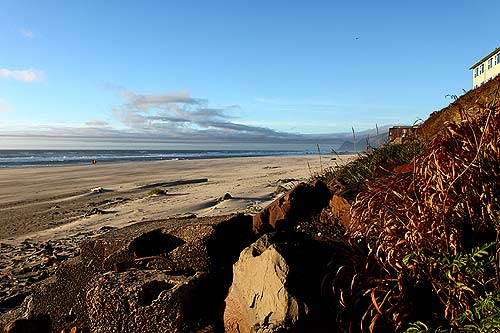Oregon Astronomy: Summer Solstice Facts, Parties in Coast Range, Portland
Published 06/19/2019 at 5:53 PM PDT
By Oregon Coast Beach Connection staff

Includes exclusive listings; some specials in winter
In Cannon Beach:
Includes rentals not listed anywhere else
In Manzanita, Wheeler, Rockaway Beach:
Some specials for winter
In Pacific City, Oceanside:
Some specials for winter
In Lincoln City:
Some specials for winter
In Depoe Bay, Gleneden Beach:
Some specials for winter
In Newport:
Look for some specials
In Waldport
Some specials for winter
In Yachats, Florence
Some specials for winter
(Oregon Coast) – Summer begins – officially – any minute now. Though we’ve already seen 90-degree days in Portland and the valley, and 80 degrees on the Oregon coast, actual summer doesn’t happen until the summer solstice, which is Friday, June 21.
There will be science-based star watching parties in Portland and in the Oregon Coast Range to celebrate this.
According to OMSI’s Jim Todd, it officially begins at 8:54 a.m. that day, the precise moment when the Earth is tilted from the north pole to its closest point to the sun.
There’s a surprise astronomical twist to this, however.
“Yet, the earth will be at its farthest distance from the sun, called aphelion, on July 5,” Todd said.
Summer solstice happens at the exact time that the Earth’s axial tilt is pointing towards the sun, reaching its maximum of 23° 26', Todd said.
“Though the summer solstice is an instant in time, the term is also colloquially used like Midsummer to refer to the day on which it occurs,” Todd said. “Except in the Polar Regions (where daylight is continuous for many months during the spring and summer), the day on which the summer solstice occurs is the day of the year with the longest period of daylight. Thus the seasonal significance of the Summer solstice is in the reversal of the gradual shortening of nights and lengthening of days. The summer solstice occurs in June in the Northern Hemisphere and in December in the Southern Hemisphere.”
Another fun fact about the Oregon coast and the daylight hours: if you want an extra few minutes of daylight, the ocean region of the state sees the sun go down about seven to ten minutes later than inland. This time difference between the valley and the beaches shifts as you go north to south, however. The difference between the two is lower on the southern coast.
This also means sunrise happens a tad later.
On the summer solstice, the sun reaches its highest point north of the Tropic of Cancer and south of the Tropic of Capricorn.
“However, between the Tropic of Cancer and the Tropic of Capricorn, the highest sun position does not occur at the summer solstice, since the sun reaches the zenith here and it does so at different times of the year depending on the latitude of the observer,” Todd said.
As a result of all this tilting and the sun at its highest point, there will be more minutes of sunlight in the northern hemisphere than there are at any other time of the year.
On Saturday, June 22, the Rose City Astronomers and OMSI are putting together Star Parties – one in the Oregon Coast Range at LL Stub Stewart State Park and the other at OMSI in Portland.
It’s all dependent on weather, of course, but they are open to beginners as well as experts and people of all ages. They are an opportunity to view the stars and other celestial objects up close and personal through telescope and binoculars. Viewing highlights include Mercury, Mars, Jupiter, Saturn and much more.
OMSI is on Water Ave. just east of downtown Portland.
To reach L.L. "Stub" Stewart State Park, take US-26 west of Portland and turn right on OR-47.
The event starts at sunset and is free with $5 parking per vehicle at Stub. Warm clothing and a flashlight with red light are recommended. Personal telescopes and binoculars are welcome.
On the scheduled day of each OMSI Star Parties, it is suggested that interested visitors check back here for possible weather-related cancellations. See Oregon Coast Weather.
Oregon Coast Hotels in these areas - Where to eat - Maps - Virtual Tours
Cannon Beach Lodging
Nehalem Bay Lodgings
Manzanita Hotels, Lodging
Three Capes Lodging
Pacific City Hotels, Lodging
Lincoln City Lodging
Depoe Bay Lodging
Newport Lodging
Waldport Lodging
Yachats Lodging
Oregon Coast Vacation Rentals
Oregon Coast Lodging Specials
More About Oregon Coast hotels, lodging.....
More About Oregon Coast Restaurants, Dining.....
LATEST Related Oregon Coast Articles
Through 2 a.m. likely best, but some lights possible through dawn June 1 - 2. Space weather, astronomy
Rare Sperm Whale Stranding on N. Oregon Coast, Was Hit by Boat
Showing up near Gearhart, it will decompose naturally. Marine sciences
Coast Guard Barque 'America's Tall Ship' Coming to Portland Rose Fest, N. Ore...
Portland events: June 5 - 8; Astoria events June 13 - 15. Weather
Bright and Active Arietids Meteors May Hit Pre-Dawn Hours of Oregon, Washingt...
Look to east hour before sunrise and you may catch a show. Sciences, astronomy, weather
Why Now Could Be a Great Week for Spotting Killer Whales on Oregon Coast - Video
A good dozen documentations around Depoe Bay, Newport, Coos Bay, Bandon, Tillamook. Marine sciences
Summer Road Work, Traffic Issues Along Oregon Coast Include Astoria, Garibald...
Some daylight closures include bridges, OR 22, OR 18, OR 26, more. Travel tips. Seaside, Cannon Beach, Lincoln City. Travel tips
Pacific City Oregon Weather, 7-Day Forecasts, Live Conditions, Radar, Webcams...
Updated Constantly: Pacific City, Tierra Del Mar, Oregon Weather, Cams, Buoy Observations, Tides, Warnings - Alerts
Oregon Coast Has World's Oldest Harbor Seal, Celebrating 50 Years Soon
June 3 at Oregon Coast Aquarium in Newport. Newport events
Back to Oregon Coast
Contact Advertise on BeachConnection.net
All Content, unless otherwise attributed, copyright BeachConnection.net Unauthorized use or publication is not permitted


















































